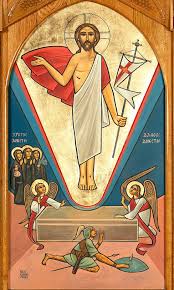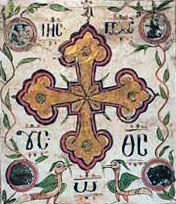

Papal Message of Resurrection Feast 2022 – translated into 21 languages
In the name of the Father, the Son, and the Holy Spirit, one God, Amen.
Ekhrestos Anesti … Alithos Anesti
I congratulate you all on the glorious Feast of the Resurrection of the year 2022. I congratulate all the dioceses, Coptic churches, and Coptic monasteries in the east and the west. I congratulate all the fathers: metropolitans, bishops, and priests and monks. I congratulate all the deacons and members of church boards everywhere. I also congratulate all the Coptic families that are celebrating the glorious Feast of the Resurrection, every family, every father, and every mother. I congratulate the youth, the servants, the elderly, and the children. I congratulate you on this joyful feast that we celebrate every year.
In the life of Christ our Lord, there are many stations. During His public service, which extended for more than three years, there were major stations of miracles, meetings, teaching, and parables, during which the Lord Christ met with His Disciples and with many people, either individually or in groups, throughout His service. One of these major stations was in the place where His Disciples gathered and went to Caesarea Philippi (Matthew 16:13) in northern Palestine. There, He asked them: “Who do men say that I, the Son of Man, am?” (Matthew 16:13). They answered Him. Then, He asked them the following question: “But who do you say that I am?” (Matthew 16:15). St. Peter the Apostle answered: “You are the Christ, the Son of the living God” (Matthew 16:16). This statement was documented in each of the four Gospels in different ways, but it was written in the light of the glorious Resurrection: “You are the Christ, the Son of the living God” (Matthew 16:16). This was an important station in the life of the Disciples. Thereafter, He began to speak about what would happen in the coming weeks and months that in His life of service, our Lord Jesus Christ would be delivered, crucified, buried, and then rise again.
Then came the Transfiguration Station (Matthew 17: 1-13), a station where three disciples were gathered. They were Peter, James, and John. Peter represents faith, James represents struggle, and John represents divine love. On Mount Tabor, they met with Jesus Christ, in the presence of Moses and Elijah the Prophets (Matthew 17:1-13). There was a conversation, and the most important part was: “Lord, it is good for us to be here” (Matthew 17:4).This is considered a glimpse of eternity, a light from eternity. This is what made the Apostle Peter ask to make three tabernacles to extend their stay in this bright and joyful scene.
After the Transfiguration, as we read in the Gospel of our teacher St. John, or in the four Gospels in general, St. Mark the Apostle may have also referred to it in his Gospel (Mark 9:9) briefly, when He said that “The Son of Man would be delivered, crucified, die, and rise from the dead.” The Disciples began to wonder: What is the resurrection from the dead? The Resurrection, my beloved, is not merely an event that took place in the past, and it is not simply a historical event.
Our celebration of the glorious Resurrection is not just a celebration that took place in the past and is over. The Resurrection is a real beginning to human existence. It is a fresh beginning for man after sin has overtaken him and defeated him, resulting in death. The Resurrection came to be that we may be victorious, and say with St. Paul the Apostle: “O Death, where is your sting? O Hades, where is your victory?” (1 Corinthians 15:55). The Resurrection of the Lord Christ is completely different from all prior miracles of resurrection, in which He raised the dead, such as the son of the widow of Nain, the daughter of Jairus, Or raising Lazarus even after four days of his presence in the tomb. The Resurrection of Christ is completely different because it is resurrection towards human existence. It is a new beginning to human life. Oh, how happy are those who enjoy this resurrection.
Let us stand together at the final scenes of the Resurrection. The first is at the Cross. It is a scene full of pain, sadness, and many sufferings. We have all passed through the Passion Week with all its readings, chants, and hymns. And we experienced and lived with the Savior hour by hour. The station at the Cross is that of pain and concludes at the tomb. Christ was crucified on the Cross, during the reign of Pontius Pilate, as we say in the Creed. Then He was placed in a new tomb where no one had been placed before. The tomb became a place where all dreams end and one of hopelessness; it is the station of death. Although this period lasted only three days, these were days of fear, panic, and terror. We sense these tribulations as we read in the four Gospels. Even the Disciples themselves were in great distress and panic. God did not leave them to fall in despair, but on the third day, Sunday’s dawn, He rose from the dead. He Who was here, Jesus Christ, “He is not here, but is risen” (Luke 24:6). We read in the Gospel of our teacher St. John: “Then the Disciples were glad when they saw the Lord” (John 20:20).This is the joy of the Resurrection by which a human becomes glad and joyful.
In the beginning of each day, we rise from sleep, and at the beginning of each midnight praise, we say: “Arise, O children of light,” O children of the Resurrection. The resurrection becomes an action, a life, and a daily presence in the human’s life. When we live the Resurrection, we not only live it during the feast’s celebration period, But the joy of the Resurrection extends and radiates throughout our Church, and on all our occasions, our feasts, and fasts, and throughout the entire liturgical calendar: Our daily matins prayer represents an enactment of the Resurrection, as we say: “In Your light, O Lord, we see the light.” On Sunday of every week, we celebrate this “day that the Lord has made.” On the 29th of every Coptic month, we celebrate and commemorate the Annunciation, the Nativity, and the Resurrection. Every year, we celebrate the Feast of the Resurrection not for a single day, but for seven weeks that end on the fiftieth day, and we call that period, “The Holy Fifties.” The celebration of the Resurrection therefore lasts not just for an hour, or a day, or a month, but the entire year. And in all our rituals, such as the rite of metanias, or the prostrations to the ground, when we kneel to the ground and say, “My Lord Jesus Christ, have mercy on me a sinner.” A person prostrates and then stands up, remembering that the Resurrection is what allowed him this blessing, to rise from his mistakes and sins.
The joy of the Resurrection must be lived by all of us. Also, we must extend it to each other. Each one of us should be a source of joy for others. The question that you can ask yourselves daily is: Did you make someone happy today? Can you, through your life, or through the meaning of the glorious Resurrection in you, or through your relationship with Christ, or by attending your Church, or through partaking of the holy Mysteries, or by reading the holy Bible. Do you make everyone around you happy? Are you a reason for joy? The Resurrection calls you to be a source of happiness for everyone.
Do not forget, beloved, that we often repeat the word “Alleluia” in the Church. Alleluia means, “Rejoice to God,” Rejoice all of you. All our spiritual practice aims for us to rejoice, and its goal is to live the Resurrection. As I said at the beginning of my talk, when Christ rose from the dead, He wanted to give us this joy to live by daily. To testify to it, teach it, practice it, and rejoice in it. The glorious Resurrection is a calling to eternal delight. All the spiritual practices we offer, their ultimate goal is to rejoice, so that our joy may be fulfilled in eternal bliss.
Do not forget that in the Resurrection, we meet with many different individuals. In the Resurrection, we rejoice with all the characters and all personalities, that were there before us in the events of the glorious Resurrection. We rejoice with John the Beloved, the only disciple who remained with Christ until the Cross. Christ entrusted him with His Mother, the Virgin Mary. This was a lesson on loyalty and an image of the Resurrection. We also rejoice with Mary Magdalene, who was the first to go to the tomb. She saw and witnessed the risen Christ and called him “‘Rabboni!’ (which is to say, Teacher)” (John 20:16). This was a lesson on loyalty as well. In the Resurrection, we also see Thomas the skeptic. Jesus appeared to His Disciples in the presence of Thomas a week after the Resurrection, while He had appeared before multiple times. Thomas was the disciple who was called by the Lord to put his finger in the print of the nails, and to put his hand into His side. So, he shouted, “My Lord and my God” (John 20:26-28).
I hope that the joy of the Resurrection fills your life always, in every church, every diocese, and with all those who serve. I send my congratulations to you from the beloved land of Egypt, I offer them to you on behalf of all the members of the Holy Synod, and on behalf of the whole Coptic Orthodox Church here in Egypt. May we all rejoice in the glorious Resurrection.
Ekhrestos Anesti … Alithos Anesti
H.H. Pope Tawadros II
The Papal message of the Glorious Feast of Resurrection - 2019
In the Name of the Father, the Son, and the Holy Spirit, One God, Amen.

Ekhristos Anesti, Alithos Anesti
Christ is risen. Truly, He is risen
I congratulate you my beloved on the feast of the resurrection according to our eastern calendar. I congratulate our entire Coptic community in each diocese and all Coptic churches worldwide spanning all five continents. I congratulate our fathers the metropolitans, bishops, priests, deacons, and all the clergy. Also all the congregation including youth, children, elders and all Coptic families. I congratulate you all on this feast that is our first joy. According to our faith and doctrine, the resurrection is the basis of Christianity.
When we contemplate the events of the Resurrection, we behold these 3 days, Friday, Saturday and Sunday. Friday of the crucifixion or Good Friday; Then joyful Saturday, the Saturday of expectation; Then Sunday of the Resurrection, that is the Sunday of victory. Let us review what St. Paul wrote when he spoke about Christianity. He was a philosopher and great theologian. In his 14 epistles, he wrote extensively about Christ, the church, the resurrection, and eternal life. However, in his first epistle to the Corinthians, chapter 13, He wrote an immortal poem about love, written in 13 verses. In the last verse, he mentions ‘Faith, Hope and Love, but the greatest is Love.’ (1 Corinthians 13:13). These three are the three days that altered the history of the world and life of humanity.
created with
Nicepage.